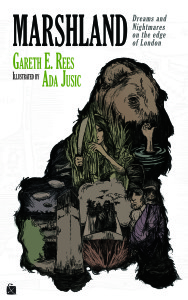Gareth E. Rees, with illustrations by Ada Jusic, Marshland: Dreams and Nightmares on the Edge of London (London, Influx Press, 2013)
In the lower Lea Valley the river carves a border between the modern boroughs of Hackney, Leyton and Waltham Forest, and the historical counties of Middlesex and Essex.
I’ve followed Gareth Rees’s work for a couple years now, both on Twitter and through that wonderful compendium of a blog he has created, the Marshman Chronicles. Combining topographical observations, fiction, myth, local history, music and the downright weird, Marshman Chronicles all but defies definition.
So I thought I knew what to expect with Gareth’s new book, Marshland: Dreams and Nightmares on the Edge of London. It would be a stretched-out version of the blog, right? Or perhaps something akin to another volume from the Iain Sinclair oeuvre, the two of them stalk the same East London manor, after all.
Well, just thirty-odd pages into this reassuringly fat volume, I realised I was wrong. Gareth Rees is no copyist of Sinclair, Papadimitriou, Self nor any of the other usual suspects of British psychogeography. He has his own unique style and his work has the assured flow of someone who was born to write.
Yes, Marshland does feature many of the elements Gareth has already explored in his blog. But the scale is bigger, the scope is broader and a whole new world of possibilities is introduced. A world that stretches out from the few hundred acres of Hackney Marsh in East London, into an infinite universe of myth and imagination.
Marshland is a rich tapestry of themes, styles and voices. Gareth Rees draws the reader in with what initially seems to be a straightforward and comfortable walking guide through the marshes of East London. Then, suddenly, he whisks us away on a magic carpet ride of myth, fiction, poetry, natural history and archaeology. There is found fiction here in its most profound form: Gareth finds people, stories, detritus, graffiti and brings them to life before our eyes:
We enter woodland where an uprooted tree trunk lies on its side. Fag butts and cans littering the crater it exposes. Broken concrete slabs are piled in a heap. Rubber tubing snakes from the heap and vanishes under a wire fence. One of the trees is wrapped with frayed rope, a wooden stick dangling menacingly from the end. Is this a warning sign? An occult symbol? An asphyxiation tool? Embedded in the moss on the ground is a bottle of DESPERADOS. Tequila mixed with beer. As if beer isn’t enough. As if tequila needed something else.
Gareth’s prose is clear and simple; he is not given to exploring the outer margins of literary experimentation. But perhaps it’s just as well that he keeps the language straightforward, because much of his content is snatched from the more disturbing liminal zones of the city, and I guess even I accept there is such a thing as too much oddness.
A word of appreciation also for Marshland’s illustrator, Ada Jusic. Her striking pen and ink drawings add to the power of the text, rather than detract from it.
Gareth Rees wanders the marsh with his dog, Hendrix; a kind of Johnson and Boswell double-act, though I’m not sure which is which. He takes us along rivers, around filter beds, past abandoned factories and across ancient grazing land. Much of this area has remained unchanged for centuries and, at times, all thoughts of London seem to belong to another world. But, from every direction, development is encroaching. Marshland, then, is not just a celebration by Rees of his own backyard, it is an advocate’s plea for its future.
Emily Dickinson once declared that: ‘I dwell in Possibility’. On the strength of this book, so does Gareth Rees.
Marshland: Dreams and Nightmares on the Edge of London is available from Inpress and good booksellers


Thanks for this review and to the introduction to the work of Gareth Rees. Ive signed up to follow his blog.
Thanks Christine. I’m sure that, if you like the sound of Gareth’s book, you’ll enjoy his blog.
I’ve signed up to his blog, too. Thanks, Bobby.
It’s a good blog – you won’t be disappointed!
Yes, it looks good.